Waterloo Alum Kurt Kraler curates this year’s Masterworks exhibition around the themes explored in his graduate thesis “The Generic Spectacle,” and the recently released book, “The Signs That Define Toronto.” Additionally, it features the work of four UW MArch graduates – David Ogbe, Weeney Lin, Emilie O’Neill and Kelsey Malott. Each of their projects explores the culture of a distinctive community, including Afrobeats in Nigeria, North American Chinatowns, Vancouver’s sex worker population, and Los Angeles’ Sunset Strip. I asked the authors about their work to gain insight into their interests and research process.
- David Ogbe on thesis ‘The Temple Of Afrobeat(s): Re-Imagination of The New Afrika Shrine’
- Weeney Lin on thesis ‘Chinatown as Heterotopia: Culture and the Crisis of Commodification in Toronto’s Chinatown(s)’
- Kelsey Malott on thesis ‘Revitalizing The Sunset Strip: Learning from Rock ‘n’ Roll on Los Angeles’ Sunset Boulevard’
- Kurt Kraler on thesis ‘The Generic Spectacle’
- Kurt Kraler on book ‘The Signs That Define Toronto’
Masterworks 2023 closes on Friday, 22nd of September. Don’t miss their closing reception on Monday, September 18, at 6:30pm in the Main Lecture Hall, where panelists Kurt Kraler, Marie-Paule MacDonald and Linda Zhang will present their recent work.
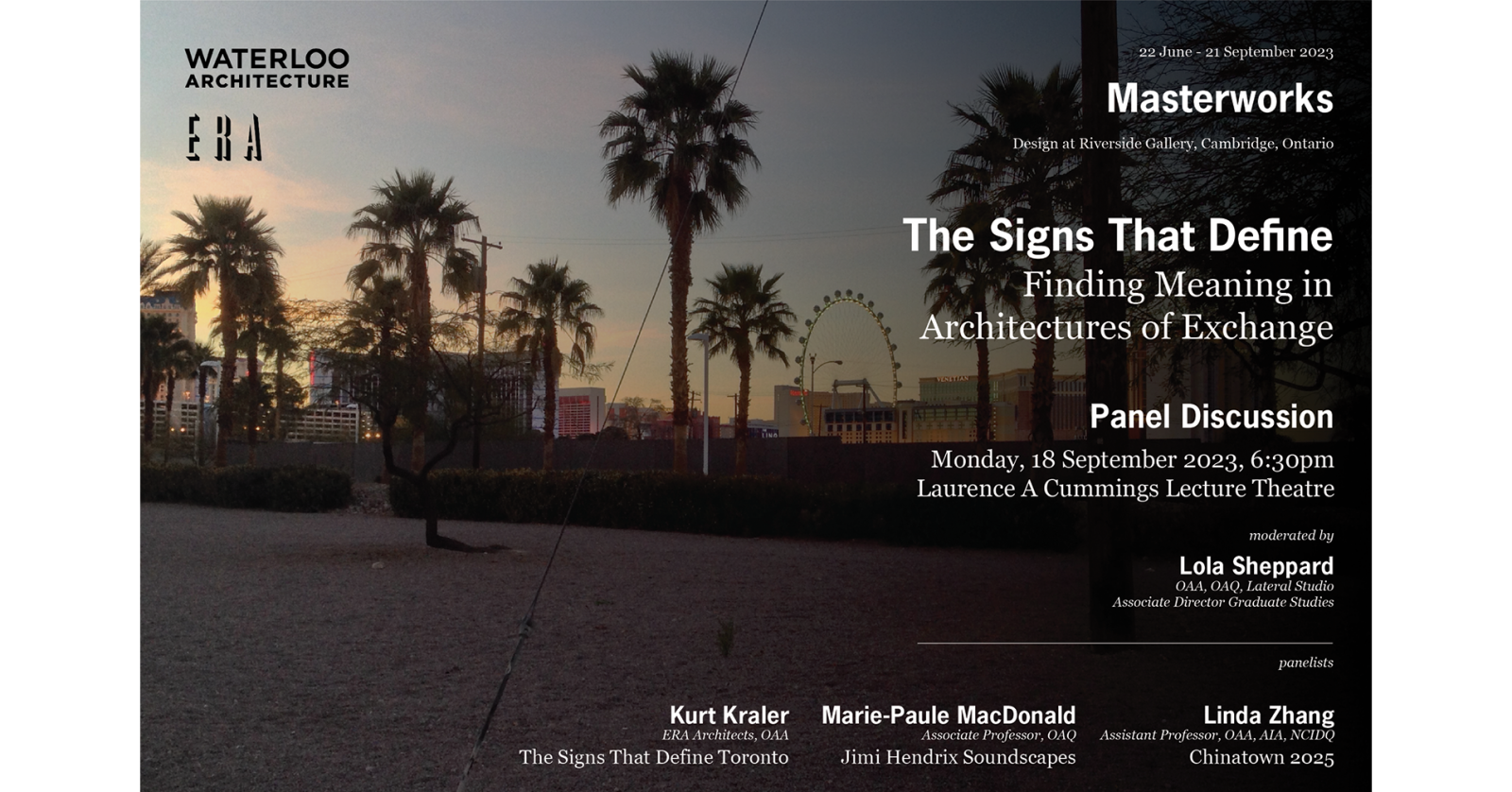
David Ogbe on thesis ‘The Temple Of Afrobeat(s): Re-Imagination of The New Afrika Shrine‘
For those who are new to your work, please provide a brief overview of your project and its primary goals.
DO: My project aims to explore the role of spatial experience design in showcasing Nigerian music, specifically Afrobeat. This exploration involves understanding the origins and key principles that define its identity, as well as researching the life and philosophy of its originator, Fela Kuti. Subsequently, applying these principles to reimagine its first recognized nightclub, The Shrine.
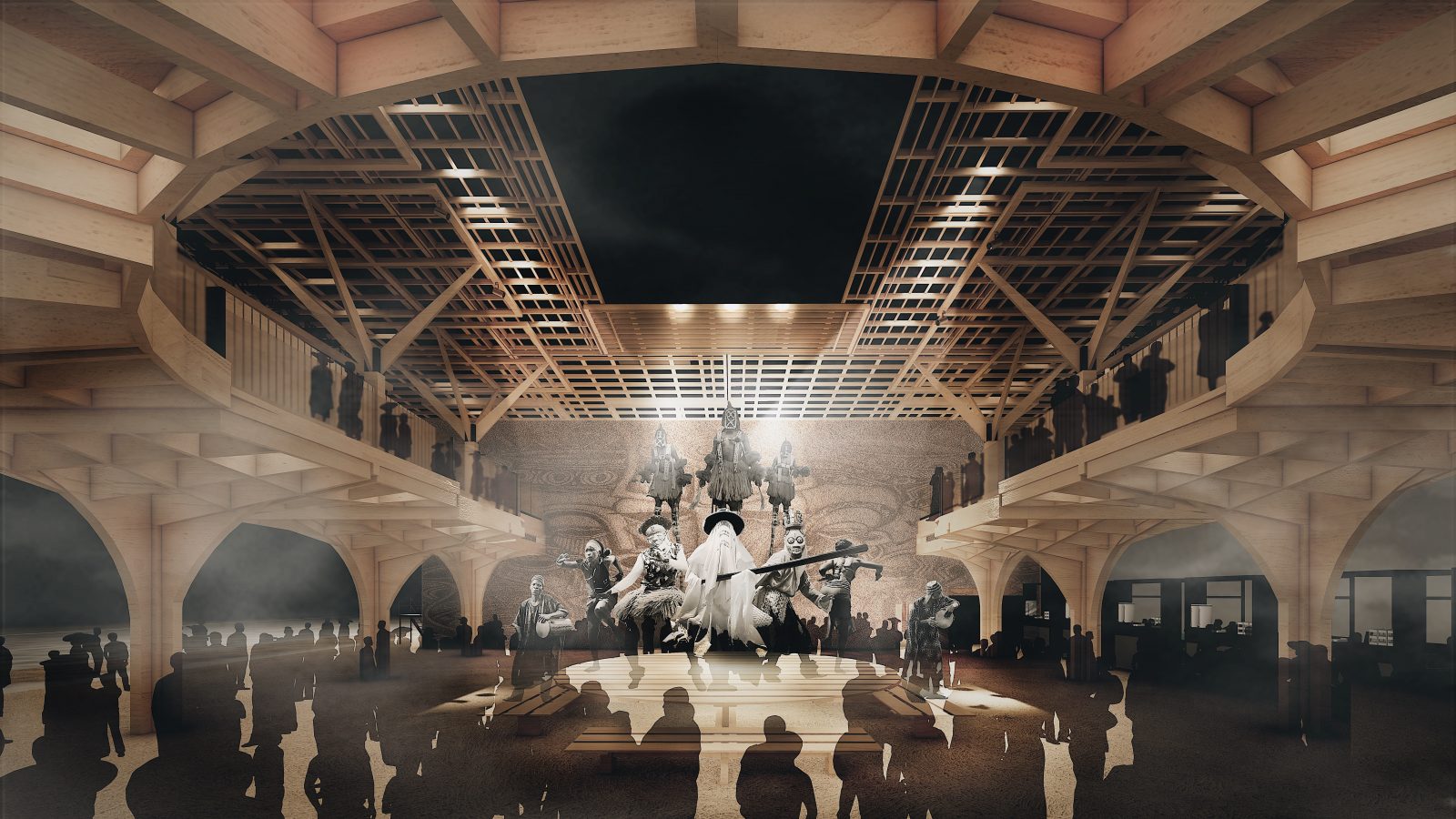
What inspired you to pursue this topic for your thesis? Can you highlight any specific aspects of your project that are particularly significant to you?
DO: The music was honestly the primary inspiration for my pursuit of this project. The aspects of the project that held particular significance for me were the materials gathered during my on-site research. Visiting The Shrine and experiencing the music live while envisioning my ideas for the project felt like the most authentic form of design for me.
How did you approach your research or design process?
DO: I aimed to understand it from a people’s perspective rather than just an architectural one. My goal was for the personal spiritual connection to the art to be the driving force behind the entire project. To achieve this, I dedicated an extensive amount of time to engaging with fans of the genre, discussing specific themes, and identifying commonalities to develop a comprehensive Afrobeat experience.
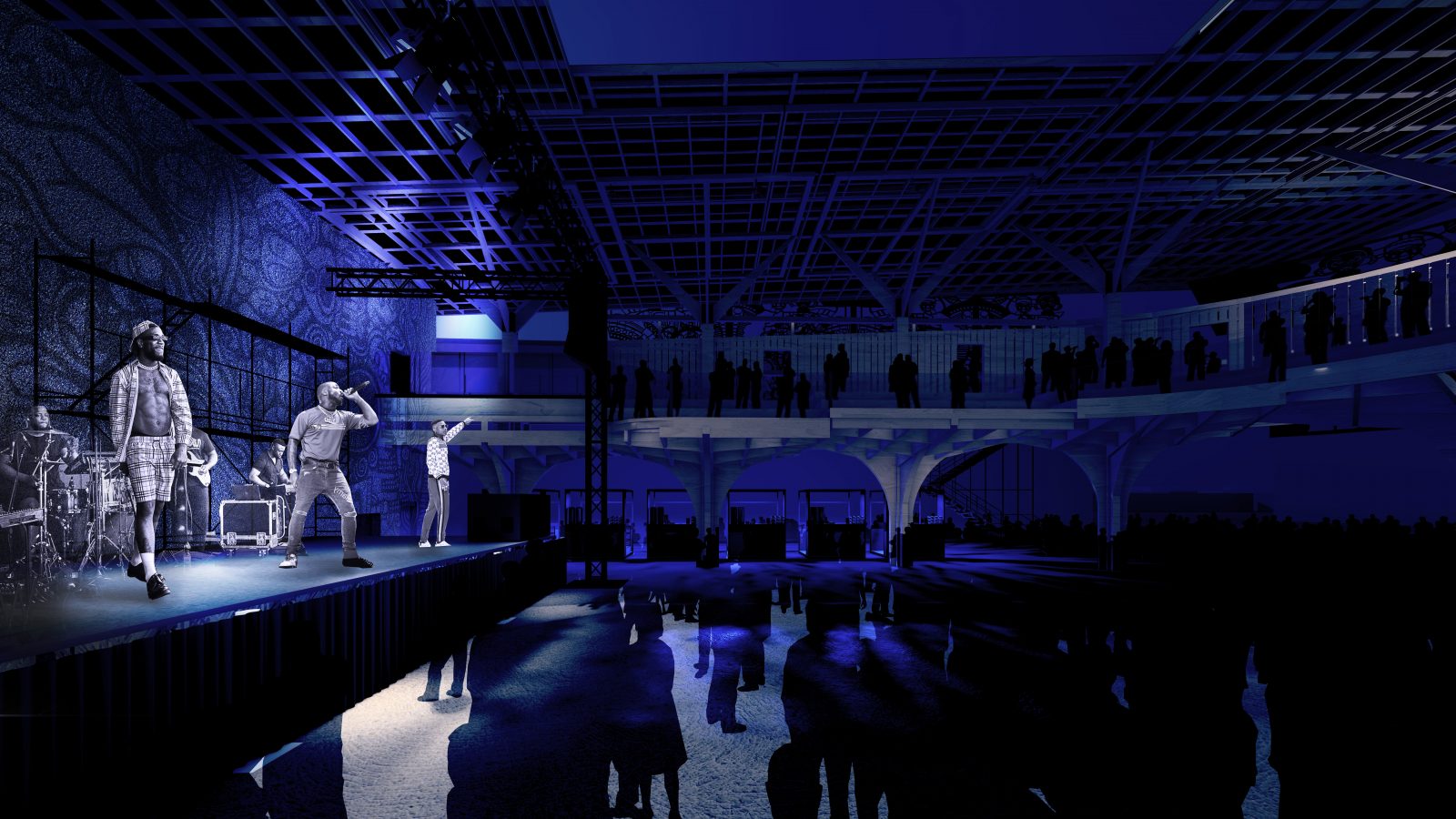
Throughout the research process, did you encounter any unexpected findings that caused a significant shift in perspective or influenced the direction of your thesis?
DO: Honestly, the project constantly evolved. A significant challenge was the limited accessibility of information and research material, which led to continuous discovery and constant shifts in the direction of the project, particularly regarding the final design.
What key challenges did you encounter while writing your thesis? If faced with similar challenges, how would you advise students currently entering their thesis year to overcome them?
DO: The primary challenge I encountered while writing my thesis was the dearth of published written material on the topic I selected, along with the limited proximity to the subject matter. If confronted with a similar issue in the future, my advice would be to remain open to alternative and unique research approaches that involve engaging with individuals in your immediate surroundings who possess firsthand experience or knowledge of such topics.
In your thesis, you aimed to re-imagine the program of The Shrine. What were some of the core values of Afrobeat that you prioritized integrating into the redesigned space?
DO: Some of the core values that I prioritized in the design included establishing a profound connection between the music and spirituality, fostering a robust sense of community engagement and development, and maintaining a steadfast commitment to curating an exceptionally enjoyable experience (a really good time!).

When designing The New Afrika Shrine, what long-term impacts did you hope your re-imagined design would have on the perception of Afrobeat and its cultural significance?
DO: One of the issues currently facing the showcase of Nigerian music, particularly in Lagos, is the lack of suitable event venues, particularly those purposefully designed for contemporary and indigenous performances. In the long term, my hope is that a new generation of designers will delve into this subject and create spaces that fully capture the eccentricity and essence of these indigenous genres.

While researching a Nigeria-based topic from Ontario, did you experience any challenges in accessing relevant archival materials or in the cultural differences between Canada and Nigeria? If so, how did you overcome them?
DO: Yes, I did adapt to this situation, particularly because most of my thesis research was conducted during the lockdown period. Fortunately, we live in an era where global connectivity is more accessible than ever. Therefore, I employed various alternative research methods, including virtual interviews with artists and culture curators, to gather the necessary information and insights for my thesis.
David’s thesis can be downloaded on UWSpace: http://hdl.handle.net/10012/16292
Weeney Lin on thesis ‘Chinatown as Heterotopia: Culture and the Crisis of Commodification in Toronto’s Chinatown(s)’
For those who are new to your work, please provide a brief overview of your project and its primary goals.
WL: The goal for my thesis work was to document and analyze the architectural and social evolutions of Chinatowns in North America over the 20th century as a way to gain insight on the role that culture, and cultural products plays in the formation of cities. It tracks and theorizes reasons for the widespread transition of Chinatown from ethnic enclave into tourist district and the current and future impacts this cultural commodification has on the precarious communities that rely on Chinatowns for survival. Finally, while the thesis pulls stories from many Chinatowns across North America to form a pattern in an evolutionary theory, it centers Toronto’s Chinatown(s) as a point of study, comparing it to the established pattern and theorizing how it might develop into the future.

What inspired you to pursue this topic for your thesis? Can you highlight any specific aspects of your project that are particularly significant to you?
WL: I am a big consumer of popular media, and was really conscious of a particular commodified “Chinatown aesthetic”, that was particularly prevalent in movies involving Chinatown in the western canon pre-2010. This idea clashed with my own personal understanding of Toronto’s Chinatown West at Spadina and Dundas, the one Chinatown I knew intimately and where my parents found their first community in Canada. This disparity inspired me to research deeply into how this split in perception and reality came to be and how it influenced the real evolution of Chinatowns, which became the main research question for the thesis. The activity of re-analyzing the map of San Francisco Chinatown in 1885 was a sort of watershed moment in thesis development and really helped define the perception/reality narrative arc and provide clarity to the goals of this thesis.
How did you approach your research or design process?
WL: After developing a rough idea of my research question, I did a lot of literature review. I looked into both Chinatown specific and general literature from sociology and film theory, economics and planning, and immigration. This literature review helped me further structure my arguments and formed the basis for the theory chapter of the thesis. The visual documentation on Toronto’s Chinatown was developed from archival research and personal observation on site visits.

Throughout the research process, did you encounter any unexpected findings that caused a significant shift in perspective or influenced the direction of your thesis?
WL: I didn’t really encounter any unexpected findings, rather I found that I had a lot of dead ends, due to lack of information or time constraints related to obtaining that information. For example, a big regret in this thesis is not being able to get firsthand interviews or surveys with current Chinatown community members due to time constraints and so the structure of the thesis and thesis arguments had to be adjusted to focus more on the historical/social evolution of Chinatown rather than the present day conditions of Toronto’s Chinatown, as I lacked comprehensive first-hand knowledge of the subject.
What key challenges did you encounter while writing your thesis? If faced with similar challenges, how would you advise students currently entering their thesis year to overcome them?
WL: As with many thesis students, I struggled a lot with narrowing my scope as every new piece of literature I read seemed to open up a whole new set of possibilities to explore. I’m not sure if I have the best solution to overcoming it quite yet but what helped for me was to have a running mind map of the thesis structure/arguments distilled down to their basic idea. This way you could always see, at a glance, how ideas informed each other and whether or not a new angle or idea you wanted to introduce made sense within the body of work you already have. It’s easy to lose sight of your initial goal amidst all the information amassing, but this way you always clearly know what you’re gaining and losing at every key decision crossroad.
The idea of Chinatowns as both an ethnic enclave and tourist district is intriguing. How do these two contrasting ideas impact the communities living within Chinatowns?
WL: The general idea is that at the beginning of the evolutionary arc, Chinatowns are established as ethnic enclaves and act as a place and network of mutual aid for new Chinese people immigrating into a hostile new society. It shelters and provides employment, language and financial aid to the community. The transition of Chinatowns as ethnic enclave into tourist district commodifies the inherent ‘otherness’ in Chinatown and makes Chinatown desirable financially as a ‘cultural district’ in the city. However, while this new interest from outsiders significantly increases commercial activities in Chinatown, transforming it into a shopping and food haven, it also significantly increases land and housing prices, reducing the livability of Chinatown, especially for the precarious communities that originally inhabited it, causing a widespread outmigration of the community. While it would be reductive to say that the current Chinatown gentrification is solely caused by the commodification of Chinatowns into tourist districts, it certainly plays a significant role.
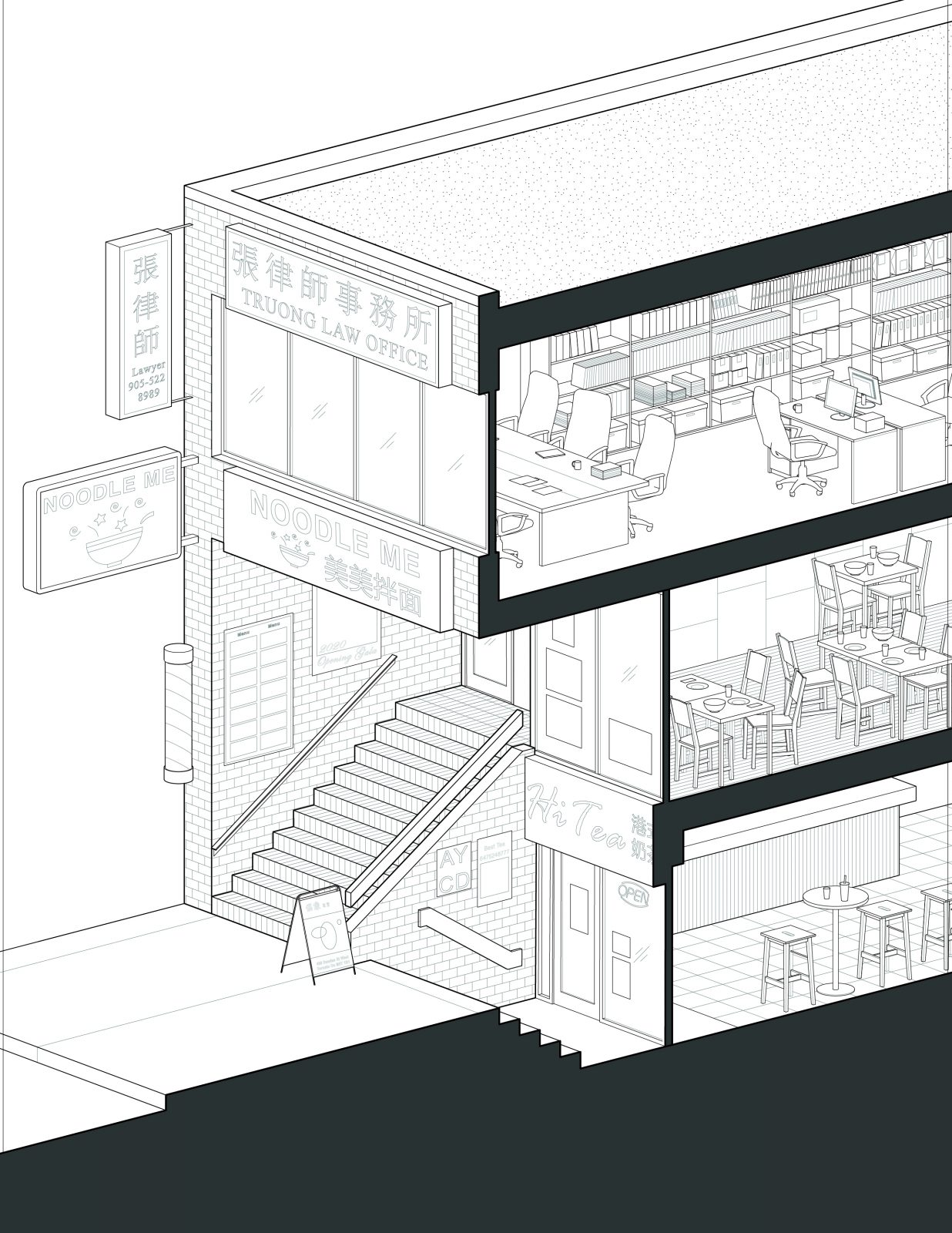
How did you navigate the complexities of understanding the voices and perspectives of various Chinatown stakeholders in your research process?
WL: While I was doing research on Toronto’s Chinatown I came upon a comprehensive sociology study by Richard A. Thompson on Toronto Chinatown demographics in the 1980s that really outlined for me what kinds of different stakeholders would be present within Chinatown. By extrapolating this study as well as reading contemporary news articles on the issues faced in Chinatown by Chinatown community members I was able to get a good sense of the various stakeholder opinions on and around Chinatown and the ethnoburbs. Again, a regret for me is not going to collect first-hand accounts on housing and business ownership.
How did community engagement or first-hand observation impact your research? Were there any moments in your interactions with Chinatown’s stakeholders that particularly resonated with or stood out to you?
WL: As explained previously. there was no first-hand community engagement, but there were many visits that I took to Chinatown to document the current built fabric, businesses, traditional associations and residences. One surprising thing that I observed was the amount of traditional associations that continue to exist in the neighborhood today. These associations held power in the original Chinatowns in the late 1800s, but as they have since lost most of their power and responsibility, I had assumed that there were very few left in Toronto’s Chinatown, especially considering Toronto’s Chinatown West was formed only about 50 years ago. It confirmed for me how much Toronto’s Chinatown West is still a thriving enclave for residents (who are unfortunately aging out) rather than a tourist district and made me question why this was.
Weeney’s thesis can be downloaded on UWSpace: http://hdl.handle.net/10012/19041
Kelsey Malott on thesis ‘Revitalizing The Sunset Strip: Learning from Rock ‘n’ Roll on Los Angeles’ Sunset Boulevard’
For those who are new to your work, please provide a brief overview of your project and its primary goals.
KM: Since the set-up of major motion-picture productions, Los Angeles County has been regarded as the entertainment capital, with West Hollywood at the forefront of the music industry. Beginning in the 1960s, a revitalized music scene filled the nightlife of a 1.5-mile segment of Sunset Boulevard, commonly referred to as the Sunset Strip, with Rock ‘n’ Roll. Songs written in the Hollywood Hills and first performed at Strip venues would be discovered, recorded, packaged, promoted and sold all along the same boulevard. Although this period of Rock ‘n’ Roll should be heavily criticized for its inequality in regard to gender, sexuality and race, it was through its civic purpose and integration into the local vernacular that Rock ‘n’ Roll found its success on the Sunset Strip. It encouraged the counterculture of this urban boulevard by considering the pedestrian scale and blending commercial content with Strip specific artistry. This thesis investigates the key contributors to the Rock ‘n’ Roll era of the Sunset Strip’s overall success. It considers how Rock ’n’ Roll provided a foundation for the architectural and urban ecological renaissance of the Sunset Strip using the attraction of popular culture, print media, and capital flows. Building on research and previous work done by Ed Ruscha, Reyner Banham, and Robert Venturi and Denise Scott Brown this thesis follows learning from ordinary and everyday architecture.

What inspired you to pursue this topic for your thesis? Can you highlight any specific aspects of your project that are particularly significant to you?
KM: I discovered the rich cultural landscape of the Sunset Strip while interning at Arquitectonica in Los Angeles in 2018. As I was raised on Rock ‘n’ Roll music, I felt immediately drawn to the Strip upon my arrival to the City. I would spend my evenings venue-hopping down Sunset Boulevard watching live performance after live performance. I had never experienced an environment as nostalgic, irreverent, and so obviously intertwined with the counterculture as the Sunset Strip. I began to recognize the familiar faces of the musicians and comedians that frequented its popular venues and learned of the many cultural revivals that contributed to the Strip’s notoriety.
So, when Arquitectonica was presented the opportunity to participate in a competition for the redesign of the city block on which the famous Sunset Strip nightclub “The Viper Room” currently sits, I was elated. Although I did not consider it would lead me down a path to which I would write an entire thesis dissertation on the matter, even then I considered The Viper Room to be a significant historical site.
Today known as The Viper Room, 8850 Sunset Boulevard is a 250-person capacity nightclub that was opened in 1993 by Johnny Depp and Tom Waits. The venue takes pride in featuring America’s favorite underground artists while also rotating an array of internationally renowned musicians such as Johnny Cash, Tom Petty and the Heartbreakers, Bruce Springsteen, Lenny Kravitz, Pearl Jam, The Strokes, Weezer, Maroon 5, and John Mayer.
When this was presented to our firm, we only felt comfortable participating in the design competition if The Viper Room was to remain programmatically intact and revamped, rather than removed completely. With a clear understanding of the venue and the existing landscape to which it belongs, our design response to the competition seemed obvious. Much like the greatest musical artists, the best architecture is an ambassador to the past, and also the future.
Sadly, our design submission for this city block did not win this competition and the project was awarded, at the time, to the Los Angeles firm Morphosis. Morphosis’ design was monumental, eye-catching, big and bold. But this design had nothing to do with the Sunset Strip. It responded in no way to the existing landscape. It ignored the human aspect of the site completely and focused purely on form (this can be most obviously seen in the complete eradication of The Viper Room from their renderings). When Morphosis’ concept design was revealed to the public, the citizens of West Hollywood were understandably provoked.
What designers are failing to realize is that successful architecture on the Sunset Strip understands the Strip’s existing environment by examining the everyday, the particularities, and the ecologies, which do not fit traditional urban tropes. Through a nonjudgmental investigation, my thesis research intended to help inspire a renewal of architectural practice out of the everyday landscape and the commercial vernacular.
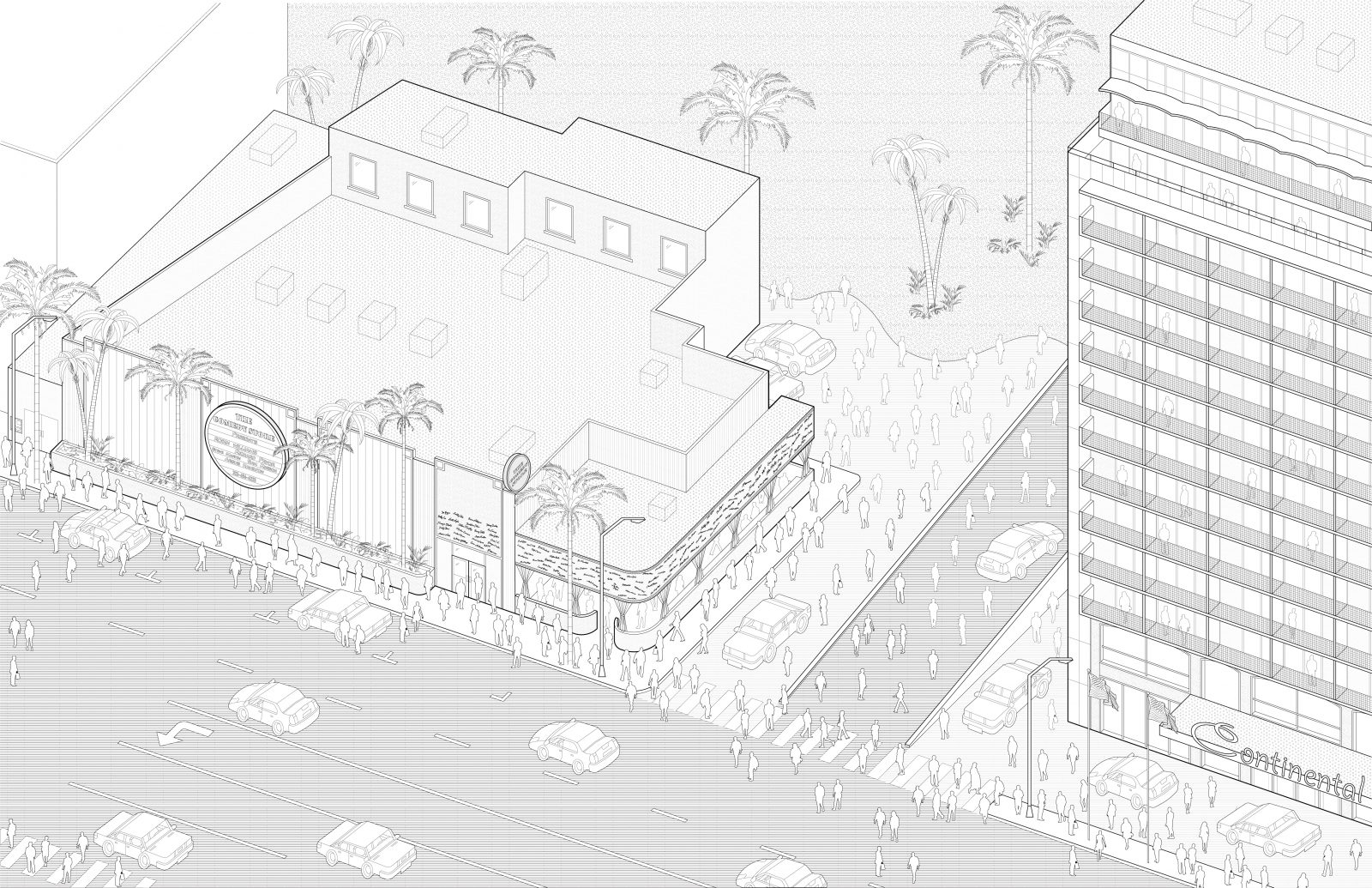
How did you approach your research or design process?
KM: By revisiting Reyner Banham’s “The Architecture of Four Ecologies”, my research identifies and analyzes this period of the Sunset Strip’s urban environment through the reinterpretation of three new ecologies: Billboards, Flyers, and the Musician’s City. I then accompanied each ecology with an architectural case study, and interview with a relevant Los Angeleno. These ecologies are followed by a brief note on the challenge of staying relevant in the dynamic landscape of the Sunset Strip.
Throughout the research process, did you encounter any unexpected findings that caused a significant shift in perspective or influenced the direction of your thesis?
Once I was able to piece together that dynamism and event eclipse monumentality and even architecture on the Sunset Strip, I was able to understand the direction of my thesis much more clearly. As Reyner Banham emphasizes in The Architecture of Four Ecologies, “Los Angeles threatens the intellectual repose and professional livelihood of many architects, artists, planners, and environmentalists because it breaks the rules of urban design.”
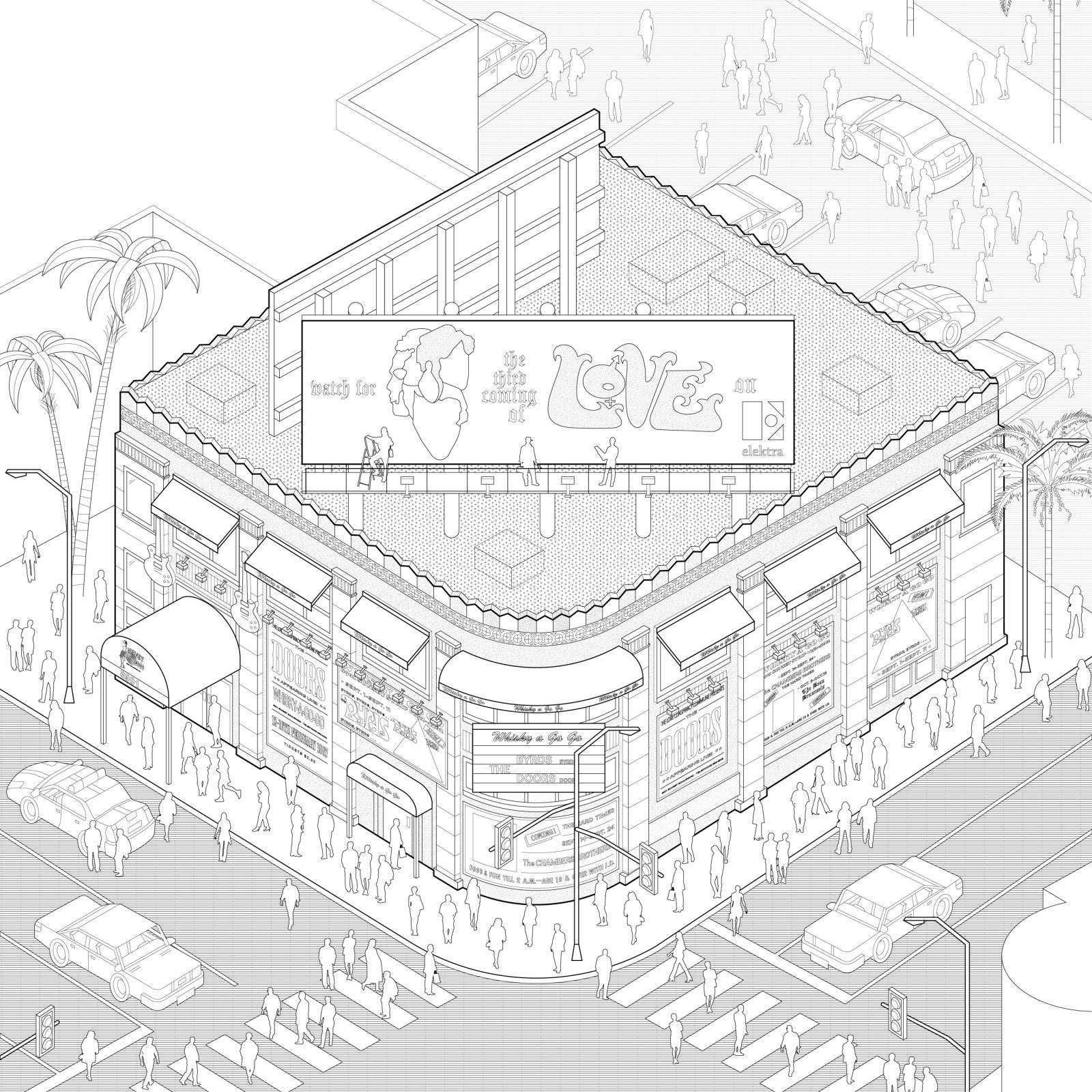
What key challenges did you encounter while writing your thesis? If faced with similar challenges, how would you advise students currently entering their thesis year to overcome them?
KM: I found it challenging to stay on topic. While researching such a historically rich environment, especially at the scale of a Boulevard, it is easy to run round in circles of content. I found that writing, and re-writing my Abstract weekly (sometimes daily) was extremely helpful.
Could you outline some challenges that stood out to you in preserving the unique character of the Sunset Strip amidst evolving urban development and commercialization?
KM: It is important to acknowledge the difficulty of holding onto something that was a product of a particular time. It would be nearly impossible to retain this period of the Strip without it becoming some sort of museum.
In your thesis, you discussed the relevance and homogeneity of proposed developments on the Sunset Strip. Did any of these proposals particularly stand out to you, and why?
KM: Since graduation, working with Arquitectonica, we have returned to working on the 8850 Sunset Project. Through our collaborative efforts with Ownership, the planning department and the City of West Hollywood, I am proud to be a part of this design. In addition to a reinspired Viper Room, this proposal includes a large Sunset level public outdoor terrace, a mixed use program with residential and hospitality levels, and programmable billboards and LED lighting bands that can be set to “override” mode to allow the City of West Hollywood to promote on-site events like WeHo Pride.
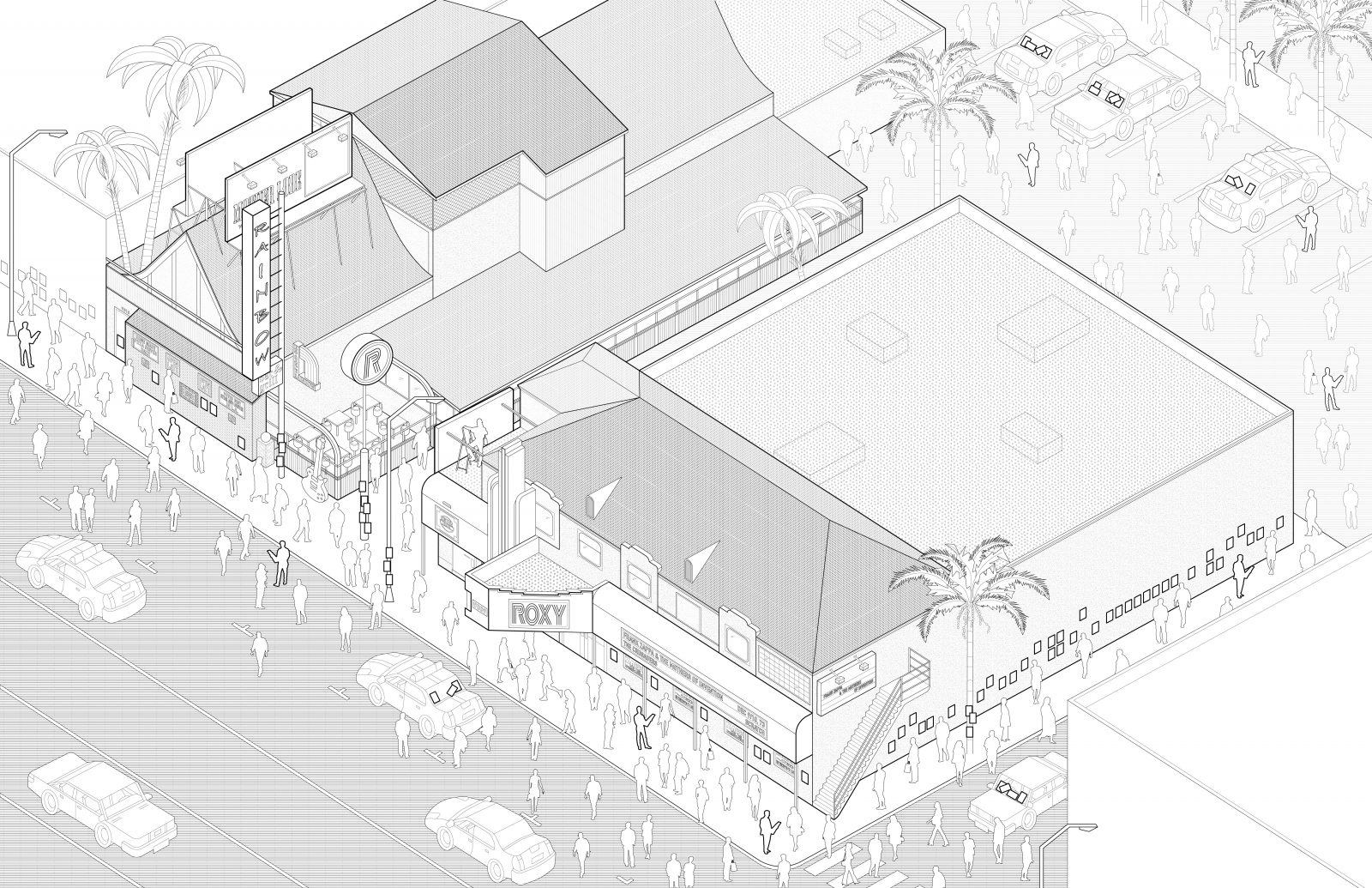
What research methods and sources did you find most successful in tracing the historical evolution of the Sunset Strip’s music scene and urban environment?
KM: I am especially thankful to the Facebook group, “I Survived the Sunset Strip in the ’90s.” Without this group, my research would be nowhere as historically accurate, nor would I have found my interview participants Lisa Smith, Stevie Rachelle, Mike Schneider, Tanzal Thorne, Jamie Wall, and Skum Love. Interviewing this wide range of musical performers, doormen, waitresses, and promoters provided added depth and personalized context to the research I was able to otherwise find.
Kelsey’s thesis can be downloaded on UWSpace: http://hdl.handle.net/10012/16215
Kurt Kraler on thesis ‘The Generic Spectacle’
For those who are new to your work, please provide a brief overview of your project and its primary goals.
KK: My graduate thesis documented, analyzed, and theorized the history of development in Las Vegas. Starting with the prolific text “Learning From Las Vegas” by Robert Venturi, Denise Scott-Brown and Steven Izenour, I focused on more recent developments since the book’s initial publication in the 1970s. The concept, termed “The Generic Spectacle” is a synthesis of Guy Debord’s writing and Rem Koolhaas’ notion of the sprawling “generic city.” It describes an urban condition whose sole intention is to generate capital, using images and various signs to masquerade as the real thing. Through my thesis, I describe how Las Vegas exemplifies this condition that is now being replicated in other city centers.

What inspired you to pursue this topic for your thesis? Can you highlight any specific aspects of your project that are particularly significant to you?
KK: I’ve always had an interest in themed spaces, camp, decoration, and pop culture. Naturally, this led me to study Las Vegas as it incorporates all these elements. I had initially wanted to look into the development of Disney World but their archives are notoriously hard to access which would have made the research process much more difficult. The appeal of Las Vegas was that it has a rich history of various stakeholders competing to become the dominant hotel/casino brand, producing some peculiar outcomes and unusual urban conditions that Disney never had to contend with.
How did you approach your research or design process?
KK: I scheduled a research trip and visited the archives at UNLV, just off the Strip. I stayed a week and also took the opportunity to go on long walks, observing the people and how they navigated the architecture. Through photography and sketching, I documented both the Las Vegas Strip as well as the peripheral areas that support it. It’s incredible to notice the sheer scale of infrastructure that supports the operation of the bustling commercial corridor.
Throughout the research process, did you encounter any unexpected findings that caused a significant shift in perspective or influenced the direction of your thesis?
KK: One significant find was that there weren’t a lot of historic buildings on the Strip as they were mostly demolished for newer, flashier buildings in a bid to attract more tourists. After a visit to the Neon Museum, I realized that old signs were often the only remnants of these historic places and served as a means to convey the region’s history. The museum does guided tours where visitors can hear about the stories behind the signs and why they were significant.

What key challenges did you encounter while writing your thesis? If faced with similar challenges, how would you advise students currently entering their thesis year to overcome them?
KK: A key challenge was being taken seriously! When you first tell people you are studying Las Vegas for your architecture graduate thesis, they often think I’m joking. I continued to push through however and found a thesis supervisor, Adrian Blackwell, who understand the direction I wanted to take my thesis in. I was able to develop a body of work that thoroughly examined the Strip as a serious architectural precedent and attempt to make it relevant to the broader discourse.
Since publishing your thesis in 2016, have you come across any new examples from other urban developments that you believe CityCenter could learn from or be compared to in terms of its successes or failures?
KK: I’ve noticed the conditions the produce “The Generic Spectacle” in countless urban centres. One particular example is the redevelopment of downtown Detroit. With the hollowing out of the downtown core as a result of capitalist extraction, the city is now dominated by large development projects including an arena, a baseball stadium, and several casinos. This trajectory of urban development emulates the development of the Las Vegas Strip, with large swaths of land consolidating under a single owner. It is also evident in other cities as condo developments take over entire city blocks. One remedy that has emerged, has been the work of block-busting community land trusts that strategically acquire properties in order to discourage developers from developing entire city blocks. This often works to ensure that smaller properties, often with deeply affordable housing units, remain in the community.
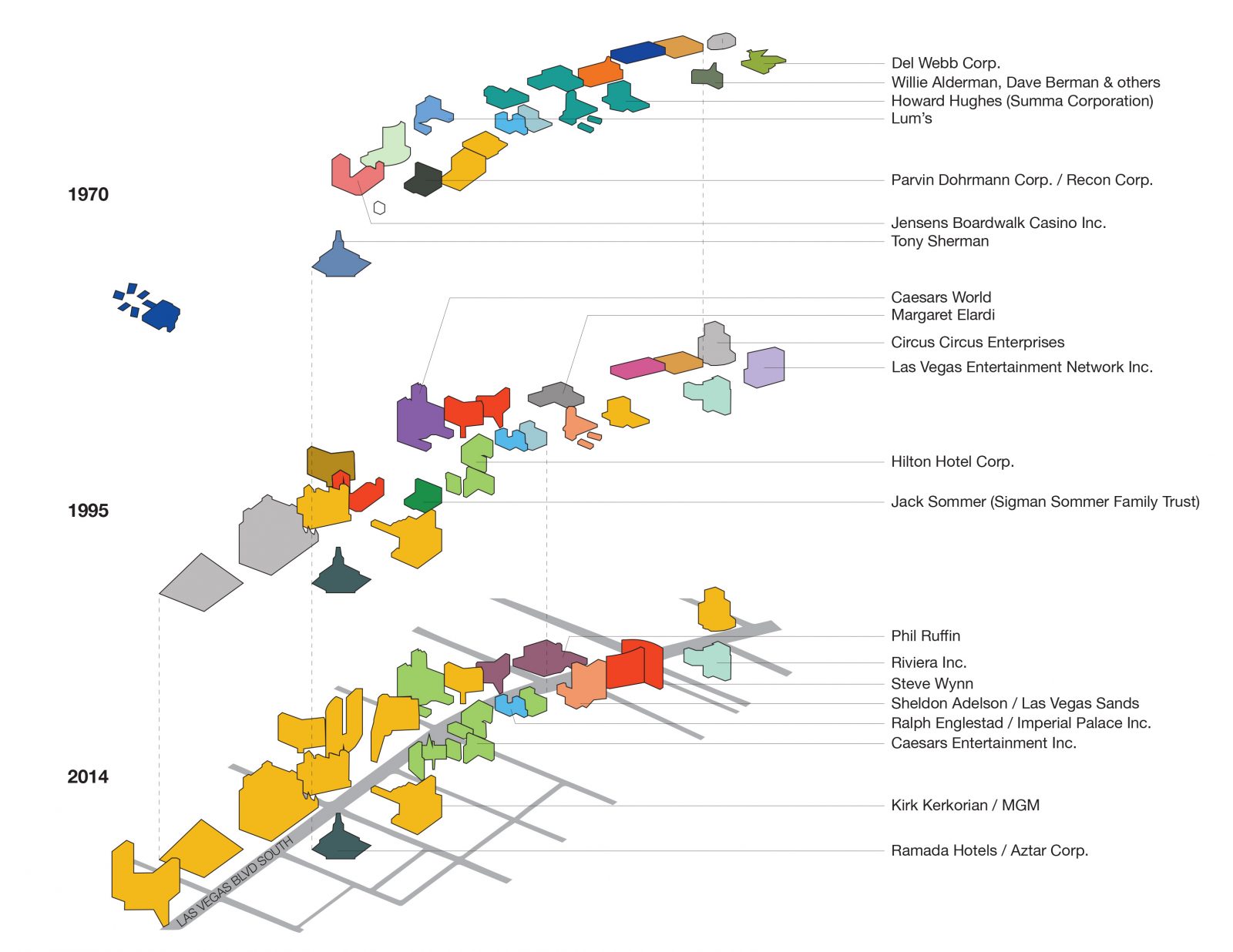
Could you give us an overview of how CityCenter resort’s design failed to achieve pedestrian accessibility and other desired urban planning principles?
KK: In my thesis, I argue that the CityCenter development in Las Vegas masquerades as an all-encompassing, self-sustaining city, delineating the boundary between public and private space. As a result, what appears to be public is actually entirely private. The development uses the language of urban design and architecture as a theme for what is essentially a luxury hotel casino resort. There is minimal outdoor space, instead visitors are encouraged to traverse the site though its many interior corridors that are lined with shops, casinos, and restaurants. The goal of the resort is to generate as much profit as possible, not to provide a livable city for residents as it seems to suggest through its theming.
Did your thesis topic and research process influence your career as an architect following your graduation from the MArch program?
KK: In writing my thesis and reading Debord’s work in particular, I understood the importance of connecting people with a historical sense of place. That ultimately motivated me to work at an office that regularly engages with heritage buildings, like ERA Architects. Our work is driven by context, responding to an existing building and thinking about how to engage communities with their histories.
Kurt’s thesis can be downloaded on UWSpace: http://hdl.handle.net/10012/10124
Kurt Kraler on book ‘The Signs That Define Toronto’
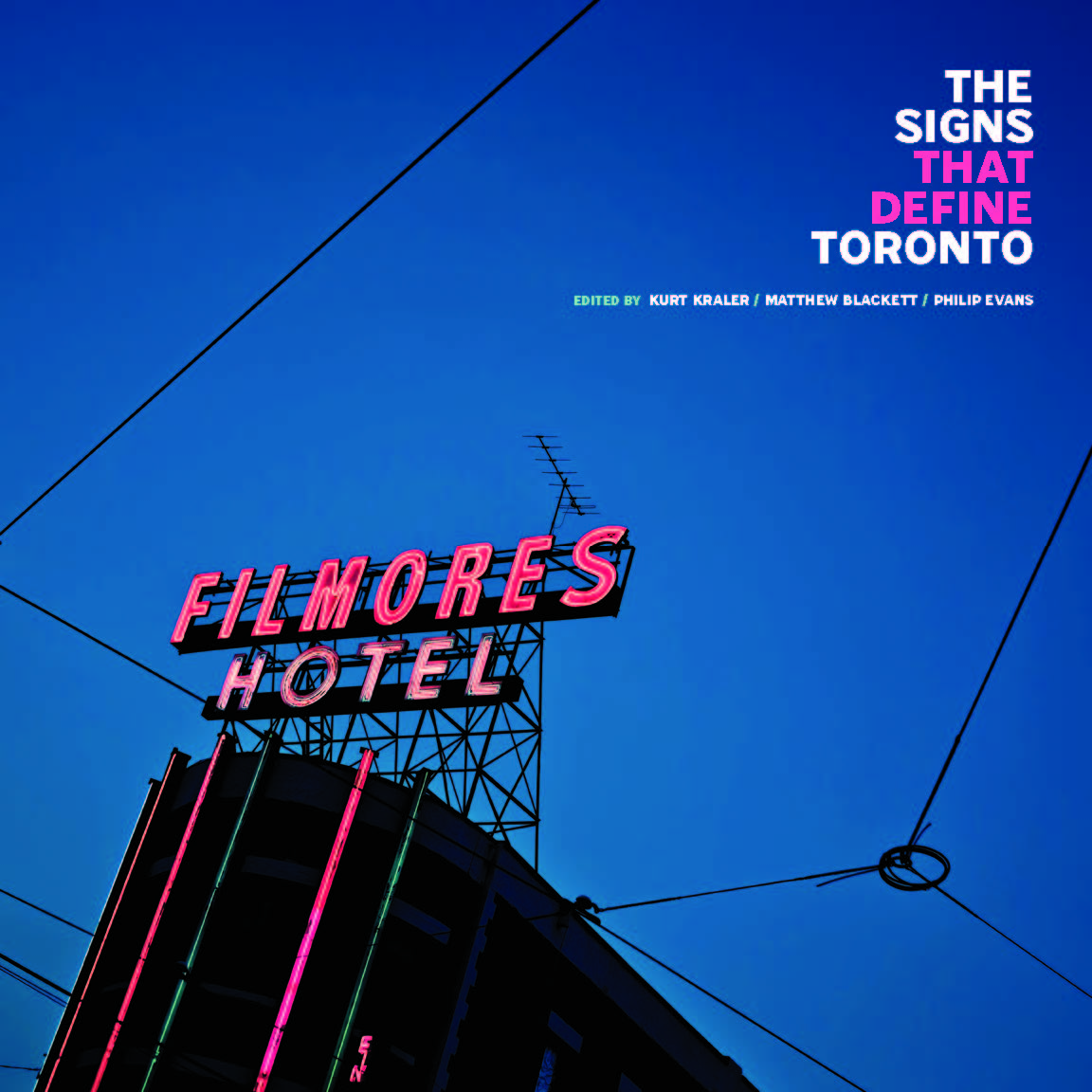
For those who are new to your book, please provide a brief overview and its primary goals.
KK: The book reveals the history, culture, and stories of Toronto through its unique signage. In many ways, the city is shaped by its signs: from the iconic marquees that dominate the streetscape to the more modest back-lit units of small businesses. Signs display the rich layers of commerce and communities in Toronto through the languages displayed, colours used, and types of businesses and services provided. There are essays, gorgeous photographs, case studies of sign restoration projects, and interviews with a sign maker, painter, and photographer. The goal was to capture the history and culture of the city as told through its many signs.
What inspired you to pursue this topic for your book? Can you highlight any specific aspects that are particularly significant to you?
KK: In my work on heritage buildings, I was coming across historic photographs that showed magnificent signs that were no longer on buildings and wondering what had happened to them. We also recently witnessed the loss of several famous signs, particularly Honest Ed’s, recognizing how rapidly the city was changing. The book was a way to tell the stories behind some of those signs and share the city’s history in the process.
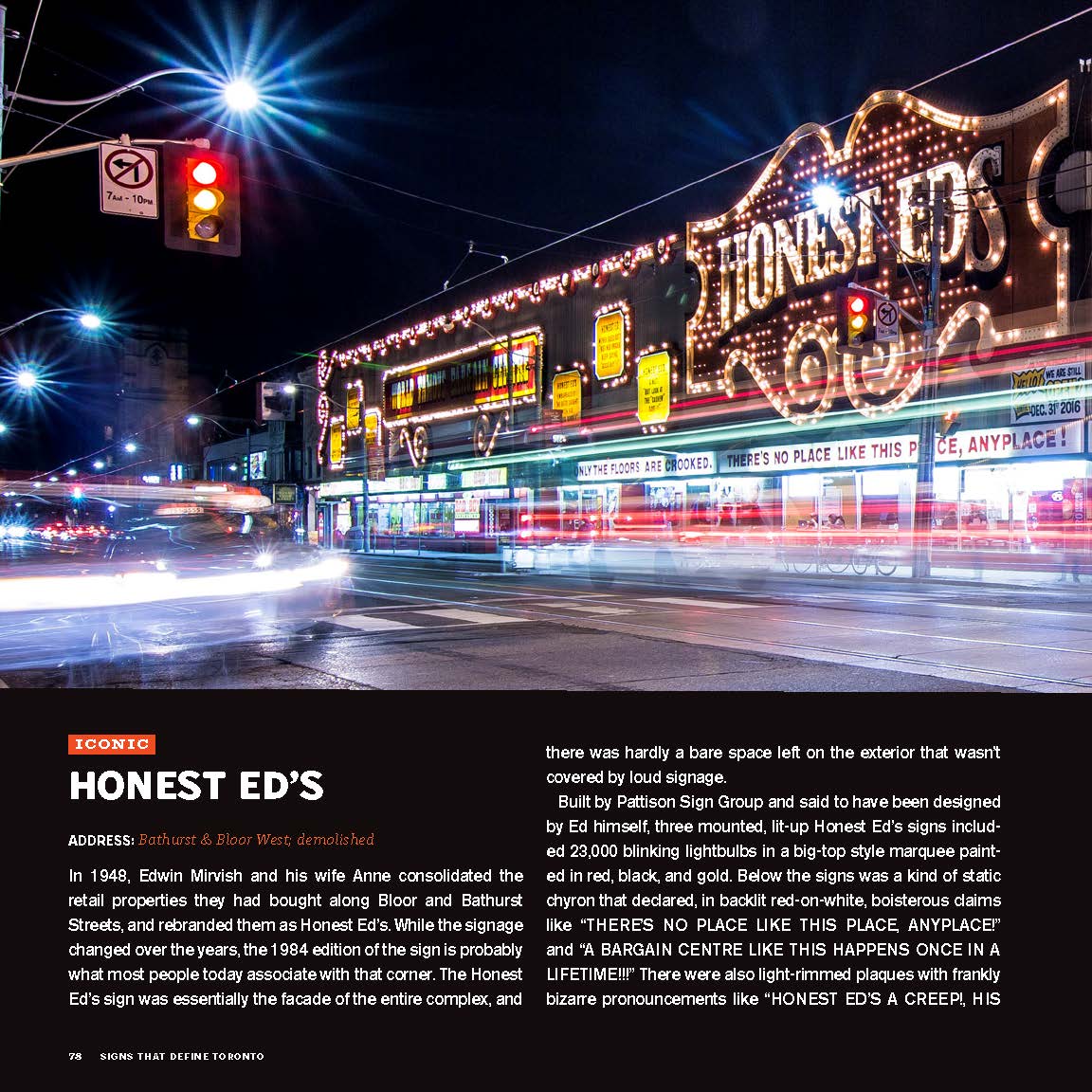
How did you approach your book’s research process?
KK: The book was originally going to focus on neon signs however, we realized we’d have to expand our focus to include other types of signs to better tell the history of Toronto and capture its culture. I had access to the ERA project folders which included research on countless historic buildings and signs in Toronto. As a result, the book includes sketches, drawings, and historic photographs of various iconic signs, most notably the Paradise Theatre and the Maple Leaf Gardens marquees. We also collaborated with various contributors with knowledge of a particular sign type or community, to round out the research.
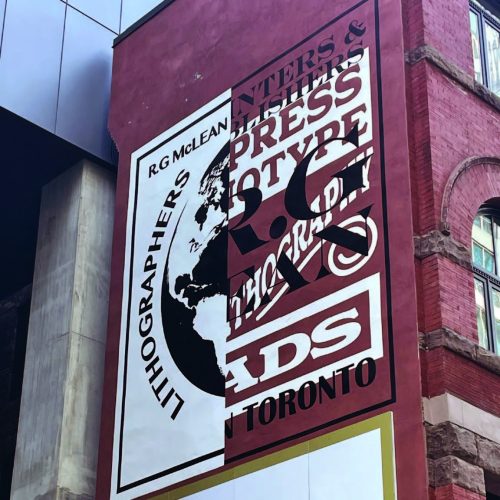
Throughout the research process, did you encounter any unexpected findings that caused a significant shift in perspective or influenced the direction of your writing?
KK: I realized during the writing of the book that we were focusing on the flashiest, more recognizable of signs and I wondered about more subtle signs. This led me to consider the signs of the 2SLGBTQ+ community, particularly during the 1960s and 1970s when the community was more underground, largely out of necessity. We tapped former Body Politic writer and prolific community activist Ed Jackson, to consider the history of queer signage in the city. He uncovered some pretty incredible stories about bar owners who had to be discreet in what they were offering while also reaching their intended target demographic – the queer community. This shifted my approach to consider perspectives that may not be immediately apparent to ensure a more robust history of the city was reflected.
What key challenges did you encounter while writing this book? If faced with similar challenges, how would you advise other writers to overcome them?
KK: One key challenge was editing down the wide selection of signs we had at our disposal. As a result, I started an Instagram account (@signsthatdefine) that would be a living document of signs that were not included in the book but could be added afterwards. The goal of the book was to include as many different types of signs from a variety of communities in the city to document a broader sense of the city’s history than has previously been captured. I’d suggest other writers consider other avenues for sharing content that isn’t just reserved for a singular publication. Can additional content by shared through blog posts, social media, lectures or walking tours? This will help to alleviate the pressure to include everything in the publication.
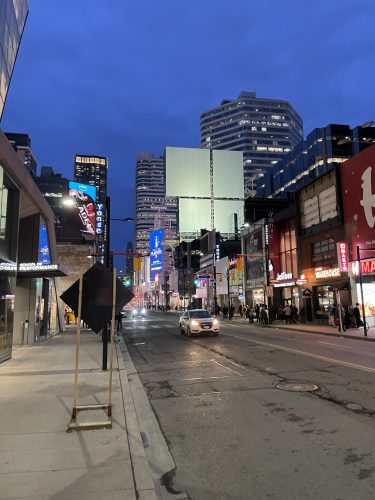
How do you see the role of signage in cities evolving in the future, and what challenges do you anticipate in preserving culturally significant signage in Toronto?
KK: Toronto Star technology writer Navneet Alang, writes about the future of signage in The Signs That Define Toronto, and he notes that signs will become a lot more interactive through the use of surveillance technology. I think signage will become a lot more dynamic, leading to a changing sense of place. If there are fewer fixed signs then there are fewer landmarks in which to navigate the city. The Toronto Neon Museum is an initiative started by the Downtown Yonge BIA to collect, store, and eventually display historic signs. They’re in the process of finding a permanent home to display the signs in their collection but do have occasional popup events where the signs on view. I’ve also received calls about signs that are at risk of being taken down and will provide direction on how best to salvage the sign. It is also important to document the signs of the city so if they are removed, there is sufficient documentation that the sign can be commemorated or even rebuilt.
Could you share some key examples of how technological changes influenced the design and role of signs in Toronto, and what are your thoughts towards these changes?
KK: One key technological shift was the introduction of a cheap, abundant supply of electricity. The city launched the Toronto Hydro-Electric System in 1911, allowing business owners to shift to dazzling sign displays in a bid to further compete with neighbouring businesses for eyeballs. This resulted in large electric marquees and neon signs, forever changing the streetscapes of Toronto and illuminating the sidewalks below. While we still have some of those signs today, many of them were removed by the 1950s when the City Beautiful movement gained traction and sought to declutter city streets and remove overhanging signs. Tatum Taylor Chaubal writes about how subway construction along Yonge Street was used as a vehicle to justify the removal of these large signs. There are still some traces of these policies in today’s sign bylaws that prohibit signs above the ground floor and new projecting signs altogether.
Can you recommend additional readings or sites to visit for those interested in further investigating the topics discussed in your book?
KK: I would starting with “Learning from Las Vegas” (Venturi, Scott-Brown, Izenour) and the follow up collection of essays, “Eyes that Saw” (van Moos, Stierli). They are both great books about Las Vegas, the relationship of signs and architecture, and responding to an existing context.

‘The Signs That Define Toronto’ is on instagram @signsthatdefine


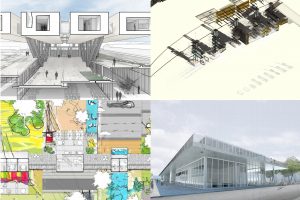
Leave a Reply